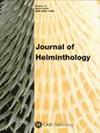爱尔兰龙头螺 Bithynia tentaculata 在其原生分布区西部边缘的吸虫物种多样性
IF 1.6
3区 生物学
Q4 PARASITOLOGY
引用次数: 0
摘要
吸虫和它们的蜗牛宿主已经形成了亲密的寄生-宿主关系,蜗牛支持着多样化的、通常是物种特异性的吸虫动物群。在龙头螺 Bithynia tentaculata(腔腹纲,Littorinimorpha)中,最近记录了一个独特的吸虫动物群。然而,由于许多物种属于分类不明确或有争议的类群,因此对确切物种身份、系统发生关系和地理分布的了解仍然有限。为了增进我们对触手虫的了解,我们研究了爱尔兰戈尔韦郡湖泊中的 556 只蜗牛,从而调查了 B. tentaculata 的触手虫动物群。利用综合分类方法,包括 DNA 序列数据分析(28S rRNA 基因、ITS1-5.8S-ITS2、ITS2、cox1、nad1)和形态学工具(分类图纸和测量结果),我们确定了 7 个科的 9 个颤形虫物种,其中 7 个物种以套鞭虫的形式出现(Cyathocotyle prussica、Lecithodendrium linstowi、Lecithodendrium sp、Asymphylodora progenetica、Sphaerostoma bramae、Metorchis xanthosomus 和 Notocotylus sp.),3 种以 metacercariae 形式出现(A. progenetica、Parasymphylodora parasquamosa 和 Sphaeridiotrema sp.)。除 S. bramae 外,其他都是爱尔兰的新物种记录,并提供了这些吸虫在欧洲最西部的分布情况。已知记录的吸虫物种使用多种确定宿主,地理分布广泛;其中包括人畜共患病属(Metorchis)和野生动物致病属(Cyathocotyle、Sphaeridiotrema和Notocotylus)的物种成员。目前仍然需要对吸虫物种进行精确鉴定,以确保正确理解更广泛的生态环境,并准确评估生物多样性和疾病威胁。本文章由计算机程序翻译,如有差异,请以英文原文为准。
Trematode species diversity in the faucet snail, Bithynia tentaculata at the western edge of its native distribution, in Ireland
Trematodes and their snail hosts have developed intimate parasite-host associations, with snails supporting a diverse and often species-specific trematode fauna. In the faucet snail, Bithynia tentaculata (Caenogastropoda, Littorinimorpha), a unique trematode fauna has been recorded recently. However, knowledge of the exact species identity, phylogenetic relationships, and geographical distribution remains limited as many of the species belong to groups with unclear or controversial taxonomical assignment. To contribute to our knowledge of the trematodes, we investigated the trematode fauna of B. tentaculata by examining a total of 556 snails from lakes in County Galway, Ireland. Using an integrative taxonomic approach including DNA sequence data analyses (28S rRNA gene, ITS1-5.8S-ITS2, ITS2, cox 1, nad 1) and morphological tools (taxonomical drawings and measurements), we identified nine trematode species of seven families, with seven species occurring as cercariae (Cyathocotyle prussica , Lecithodendrium linstowi , Lecithodendrium sp., Asymphylodora progenetica , Sphaerostoma bramae , Metorchis xanthosomus , and Notocotylus sp.) and three species occurring as metacercariae (A. progenetica , Parasymphylodora parasquamosa , and Sphaeridiotrema sp.). Except for S. bramae , all are new species records for Ireland and provide the most western distribution of these trematodes in Europe. The trematode species recorded are known to use a wide range of definitive hosts and have a wide geographical distribution; among them are species members of genera that are zoonotic (Metorchis ) and pathogenic to wildlife (Cyathocotyle , Sphaeridiotrema , and Notocotylus ). There remains an ongoing need for precise identification of the trematode species to ensure that wider ecological contexts are correctly understood and biodiversity and disease threats can be accurately evaluated.
求助全文
通过发布文献求助,成功后即可免费获取论文全文。
去求助
来源期刊

Journal of Helminthology
生物-动物学
CiteScore
2.80
自引率
12.50%
发文量
127
审稿时长
3 months
期刊介绍:
Journal of Helminthology publishes original papers and review articles on all aspects of pure and applied helminthology, particularly those helminth parasites of environmental health, medical or veterinary importance. Research papers on helminths in wildlife hosts, including plant and insect parasites, are also published along with taxonomic papers contributing to the systematics of a group. The journal will be of interest to academics and researchers involved in the fields of human and veterinary parasitology, public health, microbiology, ecology and biochemistry.
 求助内容:
求助内容: 应助结果提醒方式:
应助结果提醒方式:


